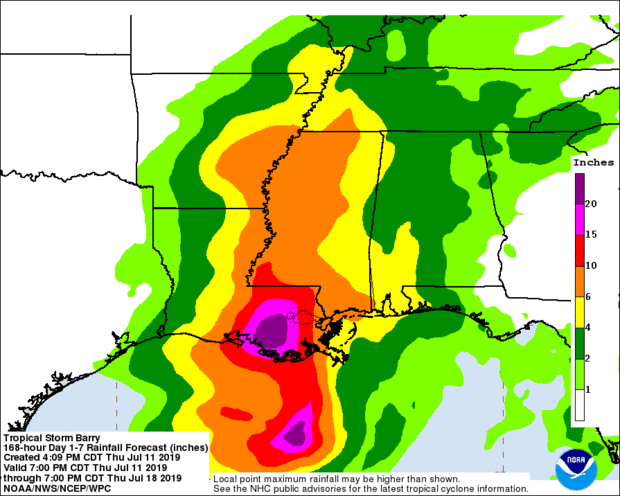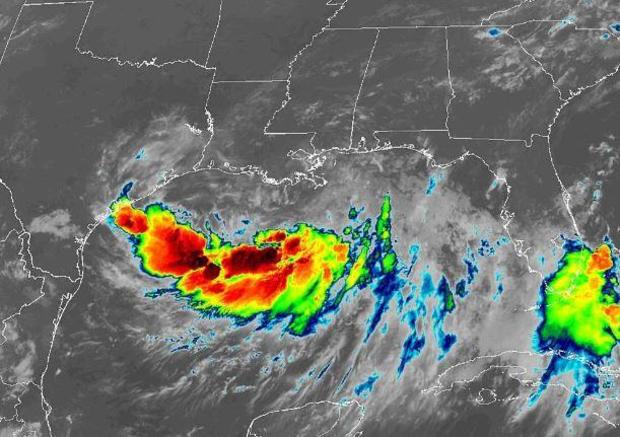Tropical Storm Barry was moving toward the Louisiana coastline Friday, and nearly 10,000 people have already been ordered to evacuate. President Trump has declared a federal emergency for the state as crews prepare for storm surge that could cause major flooding across New Orleans and surrounding areas.
The National Hurricane Center said there was a chance the slow-moving storm could strengthen into a hurricane as it comes ashore Saturday. Barry’s biggest threat will be rain with 10-20 inches expected to fall in parts of Louisiana and southwest Mississippi, the hurricane center said.
Some areas could see up to 25 inches of rain, the center said. Officials in New Orleans said the storm will be a test for the levees protecting the city.
Trending News
The Mississippi River was expected to crest at 19 feet, just a foot below the tops of the levees. National Guard troops have been deployed around the state to help those stranded by flooding.
Late Friday morning, Barry was about 100 miles southwest of the mouth of the Mississippi, and its winds had jumped to 65 mph. Tracking forecasts showed the storm continuing on toward Chicago, swelling the Mississippi River basin with water that must eventually flow south again.
Follow Tropical Storm Barry updates below
Hurricane warning in effect for parts of Louisiana
The hurricane center has issued a hurricane warning from Intracoastal City to Grand Isle in Louisiana, meaning hurricane conditions were expected somewhere within the area within the next 36 hours. Hurricane conditions were possible from the mouth of the Mississippi River to Grand Isle and from Intracoastal City to Cameron, Louisiana.
A tropical storm warning was issued for:
- From the mouth of the Pearl River to Grand Isle
- Lake Pontchartrain and Lake Maurepas, including metropolitan New Orleans
- From Intracoastal City to Cameron
Tropical storm conditions were possible from east of the mouth of the Pearl River to the Mississippi-Alabama border.
Dangerous storm surge could also occur. A warning of life-threatening inundation from rising water moving inland was issued from Intracoastal City to Biloxi, Mississippi, and for Lake Pontchartrain.
Dangerous storm surge was possible from Biloxi to the Mississippi-Alabama border.
Water covering some roads
The National Weather Service in New Orleans says water is already starting to cover some low lying roads in coastal Louisiana as Tropical Storm Barry approaches the state from the Gulf of Mexico. In a Friday morning tweet, the weather service says tides are rising and water levels are expected to peak Saturday.
“Some strengthening is expected”
The National Hurricane Center said in an advisory issued at 1 a.m. Central (2 a.m. Eastern) that Barry was still “crawling westward with little change in strength,” and promising to inundate coastal Louisiana with torrential rains.
About 80 miles from the mouth of the Mississippi River, the storm still had sustained wind speeds of 50 miles per hour.
“Some strengthening is expected during the next day or so, and Barry could become a hurricane Friday night or early Saturday when the center is near the Louisiana coast,” the advisory said, adding that the storm was then likely to weaken as it moves inland.
The outer bands of the storm were lapping at the edge of the Louisiana coast early Friday morning, CBS News’ Marc Liverman reported, heralding the start of what could be a calamitous weekend in the region.
Louisiana Gov. John Bel Edwards warned the state’s residents that it was going to be “a very significant, severe weather event and the National Weather Service, they’re using terms like ‘life- threatening floods.'”
The tropical storm’s slow track meant it was likely to deliver a deluge of water.
“There are three ways that Louisiana can flood; storm surge, high rivers, and rain. We’re going to have all three,” said Bel Edwards.
The Army Corps of Engineers said the flooded Mississippi River would likely remain contained by the 20-foot levees that protect New Orleans, but officials still warned there are limits to what the levees and water pumps can do.
The city’s Mayor, Latoya Cantrell, said the pumps were working “at optimal capacity.”
Liverman reported that some residents were taking no chances with the storm. Clarence Brocks of Phoenix, Louisiana, said he and his family were taking enough clothes for three days, along with “flashlights and good batteries and stuff like that, because that’s the routine. This area right here, you always got to evacuate.”
He said they would return after the storm, as it’s the only home they’ve ever known.
Trump declares emergency
President Trump issued a federal emergency declaration for Louisiana ahead of Tropical Storm Barry’s impact. The order frees up more federal resources and will help to coordinate the response to the looming disaster.
The National Hurricane Center issued a new advisory at 4 a.m. Central (5 a.m. Eastern) showing little change in the predicted path or potency of the storm, which is expected to inundate parts of Louisiana with severe flooding.
The center said the storm was moving “toward the west-northwest near 5 mph. A track toward the northwest is expected to begin later today, followed by a turn toward the north on Saturday. On the forecast track, the center of Barry will be near or over the central or southeastern coast of Louisiana tonight or Saturday, and then move inland into the Lower Mississippi Valley on Sunday.”
CBS News national correspondent David Begnaud reported from Grande Isle on Friday morning that the wind was already picking up.
Begnaud said more than 200 massive flood gates around the city were closed, and all eyes were on the levees that have been improved since Hurricane Katrina’s devastating blow.
The Mississippi was expected to crest at 19 feet — just a foot below the tops of the levees.
Begnaud reported that Grand Isle, one of the parishes ordered to evacuate, has five permanent drainage pumps and they’ve brought in six temporary pumps to help with the expected deluge.
FEMA personnel were already on the in Louisiana and 3,000 National Guard members were also called in to help.
New Orleans residents brace for flooding
A state of emergency has been declared and the National Guard activated in Louisiana. The storm system improvements made after Hurricane Katrina in 2005 were about to be put to the test.
In low-lying areas south of New Orleans, some residents heeded the warnings to stock up, pack up, and in some parishes, evacuate. The preparations also include closing massive flood gates and tying down shrimp boats.
In New Orleans, storms that unleashed flash-flooding Wednesday were a fresh reminder of what a deluge can do. Mayor LaToya Cantrell said drainage pumps were working, but “we cannot pump our way out of the water levels and the waterfalls that are expected to hit.”
All eyes were on the levees that protect the city. The forecasted crest was revised down on Thursday, however, and the Army Corps of Engineers said it did not expect any overtopping of the levees.



